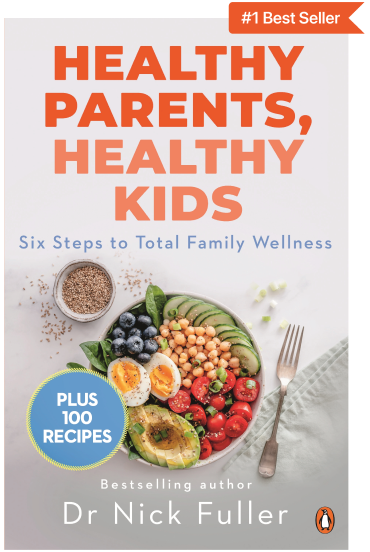The Carbonara for Kids That’s Easy and Full of Flavour

Dr Nick Fuller
Leading Obesity Expert at the University of Sydney and founder of Interval Weight Loss.

Who says creamy pasta is just for grown-ups? This recipe of carbonara for kids is here to prove that even the fussiest little food critics can fall in love with a silky, cheesy bowl of goodness. With simple ingredients and no raw egg drama, this kid-friendly twist on the Italian classic is made for busy nights and hungry tummies.
Here’s the good stuff: a 2020 analysis found that kids who regularly eat pasta tend to have better overall diet quality and lower saturated fat intake, with no differences seen in added sugar and sodium intake compared to kids who don’t eat pasta. Even better? These pasta-loving kids also consumed more fibre, folate, iron, magnesium, and vitamin E, nutrients that are key for growth and development.
So next time you're looking for a kid-approved dinner that’s tasty, nourishing, and easy to whip up, this creamy carbonara is where it’s at. Keep scrolling for your go-to recipe.
Help Your Child Try More Than Just Plain Pasta
Stuck in a cycle of buttered noodles and nothing else? Healthy Parents, Healthy Kids by Dr Nick Fuller offers practical, research-backed tips to gently expand your child’s food preferences, like moving from plain pasta to a creamy, kid-friendly carbonara.
Grab your copy of Healthy Parents, Healthy Kids today and take the pressure off mealtimes.
Why Carbonara’s Always a Hit with the Kids
Carbonara is the ultimate comfort food—rich, creamy, and simple enough to win over even the pickiest eaters. It might just be the secret weapon in your dinnertime toolkit. And with all that cheesy, savoury goodness, it’s easy to see why kids are such big fans.
- No raw egg or strong cheese: This kid-friendly version skips anything too funky or fussy. No raw eggs, no overpowering parmesan. Just smooth, mellow flavour.
- Creamy and soft texture: That velvety sauce coats the pasta like a warm hug, making it perfect for younger eaters or kids who aren’t into crunchy or chunky meals.
- Mild flavours: Carbonara doesn’t rely on spicy or intense seasonings, so it’s great for sensitive tastebuds.
- Uses simple ingredients: Just pasta, a touch of cream, cheese, and maybe some finely chopped bacon or ham. Nothing too weird or hard to pronounce!
- Easy to chew and not messy: Unlike saucy, slippery meals, carbonara clings to pasta beautifully and won’t cause chaos at the table (or in the lunchbox).
- Feels like a ‘treat’ meal without being unhealthy: It’s rich and comforting, but when made with a few smart swaps, it can sneak in protein and calcium without the sugar or deep-frying.
Kid-Friendly Zucchini Carbonara Recipe
Traditional carbonara hails from Rome and is famous for its rich, creamy texture, without actually using cream. The classic version calls for egg yolks, pecorino cheese, black pepper, and guanciale (a cured pork made from pork cheek). But let’s be real: those ingredients aren’t exactly kid favourites.
That’s why we’ve put a fun, veggie-packed twist on it with this zucchini carbonara for kids. It’s lighter, gentler on tiny tastebuds, and skips the raw egg while still delivering that creamy, comforting texture kids love. Plus, it’s a clever way to sneak in extra greens without a fuss at the dinner table.
Type: Vegetarian
Serves 4
Prep Time: 5 minutes
Cooking Time: 20 minutes
350g dried spaghetti
1 tablespoon olive oil
1 large zucchini, sliced into small pieces
4 eggs
½ cup grated pecorino Romano, or parmesan cheese
Pinch of black pepper
1. Heat a large saucepan of water over high heat and bring to the boil. Once boiling add in the spaghetti and cook for approximately 10 minutes until al dente. Reserve ½ cup of the pasta cooking water, then drain and set aside.
2. Meanwhile, heat another large frying pan over medium heat. Add in the olive oil and zucchini.
3. Fry zucchini for a couple of minutes until cooked. Turn off the heat.
4. Meanwhile, add the eggs, cheese, pepper and 1-2 tablespoons of the pasta cooking water. Whisk well to combine.
5. Once the spaghetti is cooked, add into the large frying pan and stir through the zucchini. Make sure the frying pan is off the heat, then add in the cheese and egg mixture. Mix it quickly through the pasta to ensure the eggs do not scramble. Add in some more of the reserved pasta cooking water to ensure the sauce is nice and creamy.
6. Serve the spaghetti carbonara immediately, with extra black pepper if desired. Enjoy!
Carbonara Ideas to Try With Kids
Ready to give carbonara your own twist? Here are some family-friendly variations that not only please little tastebuds but also sneak in a few nutritional wins along the way.
Chicken and Cheese Carbonara
This version swaps the traditional cured meat for shredded or diced cooked chicken, perfect for boosting the protein without adding too much salt or fat. Lean chicken is rich in B vitamins and iron, both of which are vital for a child’s energy production and cognitive development. It also adds a familiar flavour that many kids already enjoy, making it an easy dinner upgrade.
Veggie Carbonara with Peas and Corn
Sweet peas and corn add both colour and natural sweetness. It is a great way to get kids used to vegetables in their pasta. Research highlights that increasing vegetable exposure in early childhood can improve dietary variety later on. Also, peas are a good source of macronutrients, while corn contributes essential antioxidants like lutein for eye health.
Cream-Only Carbonara (No Egg)
Worried about raw egg or just want a super simple version? This egg-free variation uses light cream or milk to create a silky sauce that’s gentle on young stomachs. It’s a great option for toddlers or those with egg allergies, and you can still get a calcium and vitamin D boost from dairy, both crucial for growing bones and teeth.
Mini Pasta Shell Carbonara
Using mini pasta shells (like macaroni or small conchiglie) makes this dish more fun and manageable for little hands and mouths. These smaller shapes hold onto the sauce beautifully and reduce the risk of mess or choking. Younger children are more likely to eat foods they can easily handle, so switching up the pasta shape might actually increase acceptance of new ingredients too.
Ham and Mild Cheese Carbonara
This variation swaps guanciale or bacon with low-sodium ham and uses a mild cheese like mozzarella. It still gives that satisfying, savoury flavour without overwhelming young palates. Using lower-sodium options supports heart health early on, as excess salt intake can affect blood pressure and contribute to early stages of cardiovascular disease, starting in infancy.
Spinach and Cheese Carbonara
Finely chopped or wilted spinach blends seamlessly into the creamy sauce, adding iron, folate, and vitamin K, which are all essential for healthy blood and immune function. A study notes that offering kids a greater variety of vegetables can encourage them to choose and eat more of them. Also, serving multiple vegetable options, such as in carbonara, during lunch at school or in after-school programs is a simple yet effective way to support healthier food choices.
How to Serve Carbonara (Kid-Approved Ideas)
Want to make carbonara even more appealing to kids? A few clever serving ideas can go a long way in turning dinner into a stress-free win.
- Use colourful or divided plates – Bright plates or those with separate sections can make meals feel more fun and manageable, especially for picky eaters who prefer foods not to touch.
- Serve with cucumber sticks or cherry tomatoes – Fresh veggies on the side add crunch, colour, and a dose of fibre. Plus, pairing familiar pasta with raw veggies can gently boost acceptance of healthier sides over time.
- Top with mild grated cheese – A sprinkle of mozzarella or mild cheddar adds flavour and calcium without overwhelming young tastebuds.
- Offer in small portions for little hands – Keeping servings small helps avoid overwhelm and encourages kids to ask for more if they’re still hungry. It’s a great way to promote intuitive eating.
- Add a side of garlic bread or soft roll – Kids love having something to dip, dunk or nibble on the side. Wholegrain options add a fibre boost, too.
- Serve warm, not hot – Letting carbonara cool slightly makes it safer and more enjoyable to eat, especially for toddlers still getting used to different temperatures.
These small tweaks can help make carbonara feel exciting, familiar, and totally kid-approved.
Want to encourage your little one to try more than just pasta? Check out our guide on how to eat healthy if you’re a fussy eater for tips on building healthier habits without the mealtime battles.
Final Thoughts
Carbonara is more than just a creamy comfort food. It’s a kid-friendly classic that can be adapted in so many nutritious and delicious ways. Whether you’re sneaking in veggies, switching up the protein, or simply serving it on a fun plate with colourful sides, there’s a version to suit every little eater.
Looking for more fuss-free pasta inspiration? Check out this article on Easy Recipes for Family Meal Planning for Picky Eaters for simple, pasta-centred strategies that make weeknight dinners a breeze.
Stay informed with fresh tips, expert guidance, unique deals, and tailored support!
Meet Dr Nick Fuller
My Story
As a father, I know first-hand that raising healthy and happy children is tricky. Children are fussy, particularly at the end of the day when they are shattered. We also live in a society where companies seek to profit from what we feed our kids; incorrect and damaging advice is pushed on us and marketed towards our children, and we have no time.
But with these recipes and resources, you and your children can enjoy simple and well-founded food and lifestyle choices for lifelong health.

About Dr Nick Fuller
Dr Nick Fuller is the founder of Interval Weight Loss and is a leading obesity expert at the University of Sydney with a Ph.D. in Obesity Treatment. Dr Fuller is also the author of three best-selling books and his work been published in top ranked journals in the medical field, including JAMA, Lancet and American Journal of Clinical Nutrition.
